Physical Address
304 North Cardinal St.
Dorchester Center, MA 02124
Endometrial metaplasia is defined as epithelial differentiation that differs from the conventional morphologic appearance of endometrioid epithelium. Altered differentiation would be a better term in that its use would avoid implying that the distinction between metaplasia and neoplasia can always be made. However, for simplicity, the term metaplasia is used in this chapter.
In a sense, metaplastic changes are the so-called pathologist's disease. They are not recognized clinical disorders, and the clinician does not routinely rule out metaplasia on the pathology requisition. Rather, metaplastic changes are a spectrum of processes that may be benign or may signal the presence of a neoplastic process. When the pathologist encounters altered differentiation during the examination of endometrial biopsies or curettings, he or she must determine the risk of neoplasia and advise the clinical caregiver to pursue the most appropriate course of action.
Metaplasia in the endometrium may occur in benign conditions, arise in association with endometrial intraepithelial neoplasia (EIN) or atypical endometrial hyperplasia (AEH), or be associated with endometrial carcinomas. Because of the wide range of entities associated with metaplasia, these changes can be viewed as a parallel universe composed of altered differentiation that interdigitates with and mirrors the biology of the endometrial surface and glandular epithelium ( Table 18.1 ). Not unexpectedly, the precise distinction of an endometrial metaplastic phenomenon from a neoplastic lesion may at times be difficult, and the clinician will be tempted to use certain descriptive terms, such as atypical metaplasia or complex metaplasia, to convey the diagnostic uncertainty that these changes evoke. This chapter reviews the spectrum of altered differentiation of the endometrium, identifies changes that carry the greatest risk of cancer, and distinguishes them from those that pose a lesser risk.
| Metaplasia | Location |
|---|---|
| Papillary syncytial | Surface epithelium |
| Squamous | |
|
Surface epithelium |
|
Glands |
|
Surface and glands |
| Ciliated | Glands, surface epithelium |
| Mucinous | Glands, surface epithelium |
| Eosinophilic | Glands, surface epithelium |
| Hobnail | Glands, surface epithelium |
The prototype metaplasia in the uterus is inherently related to the transition from columnar to squamous epithelium. This transition is essentially a redirection of cell fate and begins in the lower genital tract during fetal life, when müllerian epithelium undergoes transformation to a squamous phenotype via the development of reserve or basal cells ( Fig. 18.1 ). This process occurs via the induction of p63, which is expressed in the basal cells of these primitive epithelia and mediates a redirection of cell differentiation to squamous (and urothelial) ( Fig. 18.2 ; see Fig. 18.1 ). A second consequence of this process is the appearance of reserve cells in the cervix ( Fig. 18.3A ; see Fig. 18.2A ). These cells are best known for their capacity to undergo squamous (and possibly columnar) metaplasia during adult life.
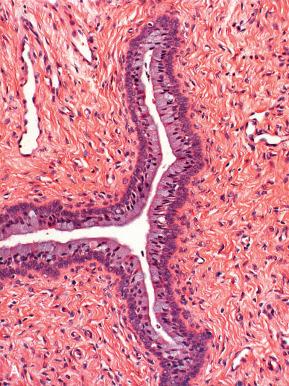
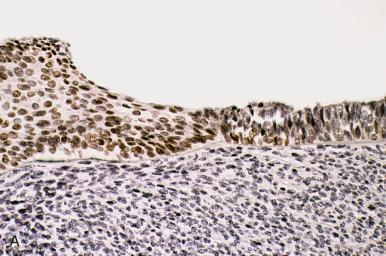
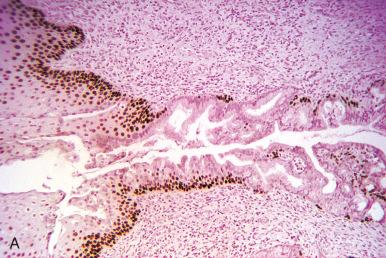
Basal cells of the prostate and myoepithelial cells of the breast have a similar reserve cell origin but are uniformly and permanently distributed beneath the columnar epithelium of their respective sites. In contrast, reserve cells of the cervix vary in distribution and number and may appear de novo at any time during the reproductive years. A commonly encountered scenario that supports the latter concept is the proliferation of columnar epithelium in the form of microglandular change, which is common in reproductive life, although its relationship with specific hormonally active conditions (contraceptives or pregnancy) remains unclear. Immunohistochemical studies have shown that this proliferation is characterized by the gradual transition from an immature columnar to a reserve cell and ultimately to a squamous phenotype (see Fig. 18.3B–D ). In this setting, the reserve cells, like the other basal or squamous epithelia generated during fetal life, are produced from proliferating müllerian columnar epithelium.
Although reserve cells are traditionally associated with the cervix, cells with a similar appearance can be identified in the endometrium. Thus, p63-positive columnar cells can be seen in the uterus during fetal life, presumably because of stromal–epithelial interactions that occur under the influence of hormones (see Fig. 18.2B ). These cells essentially disappear after birth in both the lower uterine segment and endometrium but remain in the cervix. In proliferative phase endometrium, occasional p63-positive cells may be seen; these cells are sporadically distributed in the glands, are not basal in orientation, and range from one to three nuclei per gland. Whether these cells represent endometrial reserve cells is unclear. In premenopausal women, regenerating endometrium following menstrual or anovulatory breakdown, a situation in which one might expect to find these cells, does not typically demonstrate p63-positive basal or reserve cells. However, postmenopausal endometria, particularly polyps, may be associated with foci of p63-positive basal or reserve cells ( Fig. 18.4A ). In some cases, the basal or reserve cells are not conspicuous but can be highlighted by p63 immunostaining (see Fig. 18.4B and C ). Squamous (including morular) metaplasia is strongly p63 positive and may be associated with reserve-type cells (see Fig. 18.4D and E ). The implication from these associations is that columnar epithelial cells of the uterus are capable, under certain conditions, of forming reserve-type cells. Although the cause is unknown, the alterations in hormonal status that characterize menopause coupled with epithelial–stromal breakdown and repair may set the stage for these changes to occur.
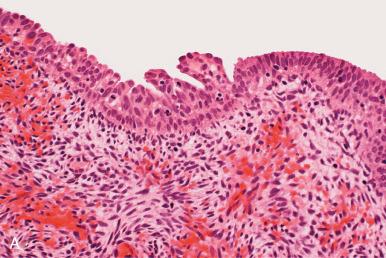
Because mucinous and tubal metaplasias occur in both the endocervix and endometrium in the absence of reserve cells, their development does not appear to be dependent on transition through a reserve cell phase. Moreover, squamous metaplasia (morules) in the endometrium may be beneath, adjacent, or superficial to the columnar epithelium, suggesting an origin directly from the columnar cells or subcolumnar reserve cells (see Fig. 18.4E and F ). Thus, at least three pathways to metaplasia may exist in the endometrial glands and surface epithelium. The first entails a direct transformation from endometrioid to ciliated mucinous or other metaplastic change, the second entails a direct transition from endometrioid to squamous, and the third entails the creation of a reserve cell population that subsequently undergoes squamous metaplasia, or perhaps another form. Conceivably, more than one pathway is initiated in the same epithelium or one pathway may lead to different alterations in differentiation, explaining the not infrequent coexistence of mucinous, tubal, or squamous elements in the same lesion (see Fig. 18.4D ). What is not clear is when and to what degree metaplastic changes in the endometrium signify neoplastic transformation, although it is likely that they are clonal in nature. To the diagnostic pathologist, the practical answer to this question is to recognize those patterns that have a high association with neoplasia.
Metaplasia may be encountered in curettings from both premenopausal and postmenopausal women. Squamous metaplasia (morules) are most common in women who are menopausal or undergoing evaluation for infertility, but they can emerge spontaneously in association with normal cycling endometrium. Other metaplasias—specifically tubal, mucinous, syncytial, and other variants—are most common in association with menopause, including hormone replacement therapy. All these forms of metaplasia exhibit a range of architectural complexity, from simple linear strips of surface or glandular epithelia to glands with architectural complexity synonymous with endometrial intraepithelial neoplasia to frank adenocarcinoma ( Fig. 18.5 ). The following is a breakdown of their categories and morphologic patterns.
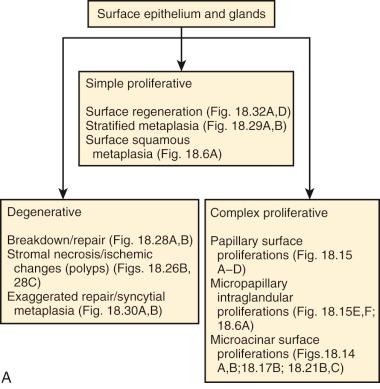
Each of the following categories illustrates a range of epithelial changes that depict a spectrum from benign to malignant. Lesions in the latter category are addressed in Chapters 17 and 19 . The portrayed range of epithelial atypias does not necessarily imply that each is part of a biologic progression or continuum. Rather, each is shown to assist the reader in identifying patterns and identifying those that deserve careful follow-up. The reader is advised that the morphologic distinction among syncytial, mucinous, ciliated (tubal), eosinophilic, and even squamous metaplasia may not always be clear-cut, inasmuch as many of these patterns may be present in the same specimen or intermingled within the same gland or focus. Moreover, certain metaplasias cannot be classified into a certain subtype, consisting only of cells with pale or eosinophilic cytoplasm and no specific form of differentiation. In such cases, architecture is a critical parameter in determining risk.
Metaplasias will be addressed from the following perspectives:
Specific metaplastic differentiation pathways will be addressed first.
These include squamous, mucinous, tubal, and eosinophilic metaplasias, which occur mostly in glands but can be seen on the surface.
Endometrial surface epithelial changes, including repair, will then be addressed.
This subset of epithelial alterations may overlap somewhat with the first, particularly with respect to mucinous proliferations, and runs through a spectrum that includes degenerative, mildly proliferative or metaplastic, and complex, with the latter raising concerns for coexisting EIN or malignancy.
Epithelial complexity within the metaplastic epithelium per se.
This will be addressed along with the two preceding perspectives and can be subdivided into three components constituting stratified, papillary, and microglandular architecture. The pathologist must always assess the degree of complexity in the associated endometrial glandular epithelium, extent of stratification and atypia in surface epithelial changes, and extent of complex architecture produced by the metaplastic process, including microglandular and papillary features.
Squamous metaplasia manifests as a range of changes from benign reactive processes to squamous differentiation in carcinomas. Benign changes include those associated with chronic endometritis, intrauterine devices, and trauma ( Fig. 18.6A and B ). Typically, this type of reactive metaplasia is present as scattered surface foci. A poorly understood variant of squamous metaplasia is ichthyosis uteri (see Fig. 18.6C ). Although such lesions have been classified as exaggerated metaplasias of the endometrium, they may be extensive, forming cystlike spaces in the myometrium, and on occasion they may be associated with squamous neoplasia. Extensive squamous proliferations, even if morphologically benign, deserve careful scrutiny, particularly in postmenopausal patients.
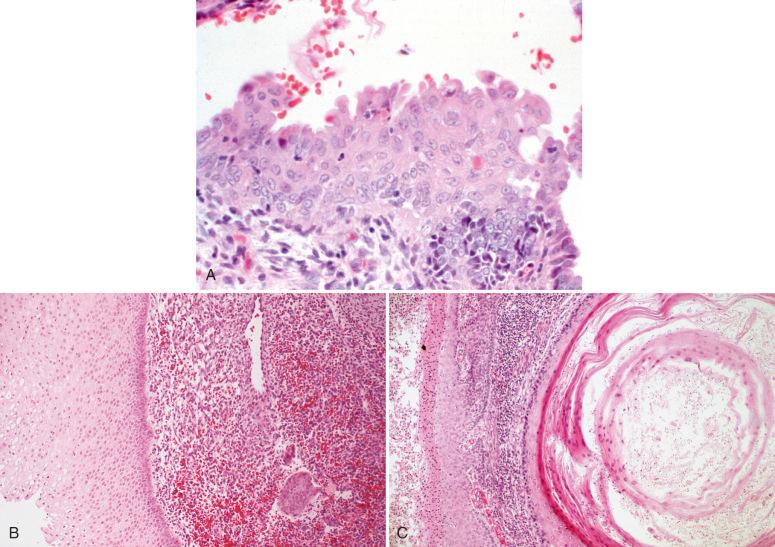
The second and more common pattern of squamous differentiation is morular metaplasia, which characteristically takes the form of small, round, cohesive, and regular granuloma-like aggregates of immature squamous cells; these are typically located within the gland tract (luminal), between glands, or as an isolated finding detached from glandular epithelium ( Fig. 18.7 ). The central location of the morule suggests replacement of the gland tract by squamous metaplasia, with a secondary proliferation of columnar epithelium, not unlike cervical microglandular metaplasia (see Fig. 18.7B ). Occasionally, morules may show central necrosis (see Fig. 18.7D ). Isolated morular metaplasia—with minimal or no glandular proliferation—is not uncommon in reproductive age women (see Fig. 18.7A and E ) and, when detached, should not be confused with histiocytic aggregates. However, morular metaplasia is frequently associated with some degree of gland crowding, which makes its interpretation more challenging (see Fig. 18.7B ).
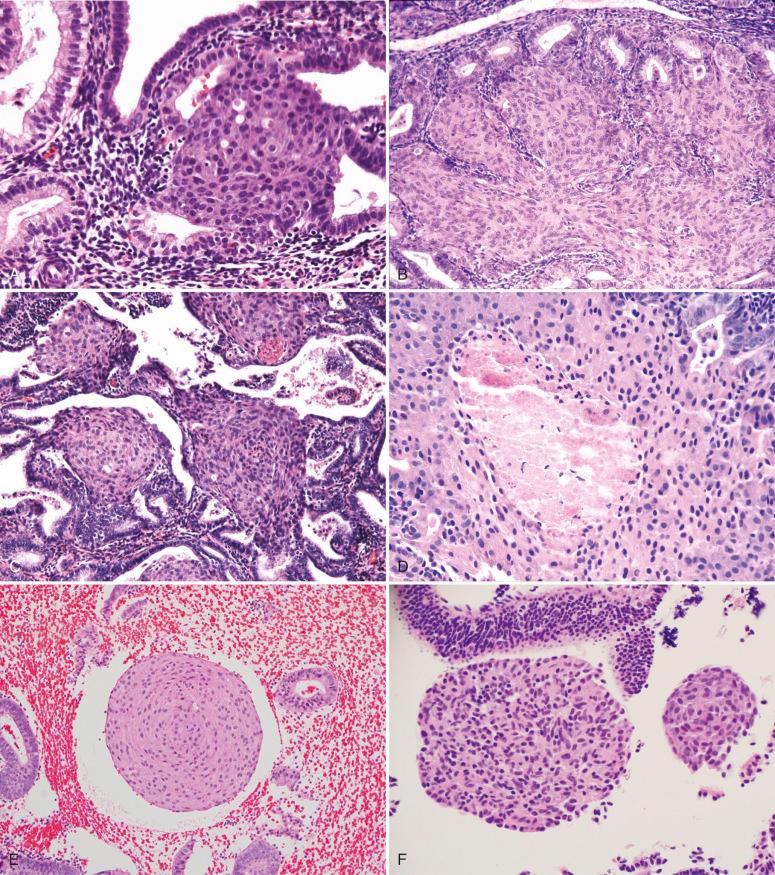
The classification of these minor gland proliferations associated with morular metaplasia is problematic, inasmuch as the degree of gland crowding or altered epithelial appearance required to justify a diagnosis of EIN may not be present. When these glandular changes are more extensive, they may raise a concern for EIN or cancer ( Figs. 18.8 and 18.9 ). The diagnostic transition from squamous morules (or morular metaplasia) to EIN with squamous differentiation requires the presence of glandular crowding and altered cytologic features within the glandular epithelium as compared with the surrounding normal endometrial glands (see Fig. 18.8 ). Nevertheless, as discussed later, gland crowding alone without cytologic changes may be a risk factor for subsequent endometrial carcinoma, irrespective of its degree of stratification and atypia.
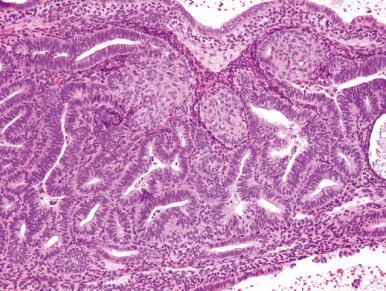
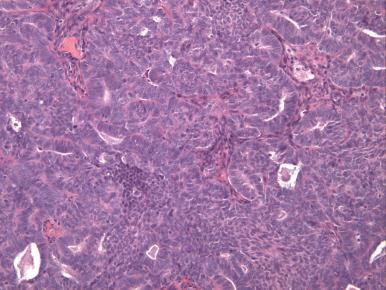
Squamous morules are cytologically and architecturally uniform in EIN, as well as in lesions that cannot be classified as EIN. In contrast, squamous differentiation associated with endometrial adenocarcinomas is more variable. In some lesions, discrete morules are present, and the diagnosis of cancer is based strictly on the glandular architecture (see Fig. 18.9 ). In others, there is aberrant differentiation or keratinization ( Fig. 18.10 ). As discussed in Chapter 19 , the terms adenoacanthoma and adenosquamous carcinoma have been abandoned in lieu of the term adenocarcinoma with squamous differentiation. In some cases, the carcinomatous glandular component may be very subtle. More poorly differentiated neoplasms include squamous carcinoma (discussed in Chapter 19 ), as well as rare, well-differentiated squamous neoplasms, including condylomata of the endometrial cavity and atypical polypoid adenomyomas.
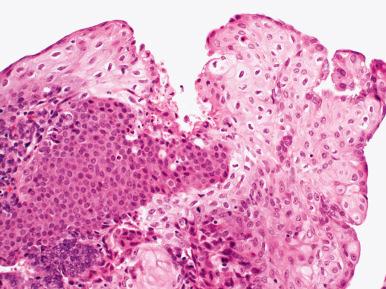
Most morular metaplasias have a benign outcome. In a follow-up study of morular metaplasia at the Brigham and Women's Hospital, we found that endometrial biopsies or curettings classified as uncomplicated (class A or B—i.e., without associated EIN) morular metaplasia usually regressed and were followed by a histologically proven endometrial adenocarcinoma in only 5% of cases ( Table 18.2 ). In contrast, morular metaplasias described in association with EIN (class C) often persisted and were followed by adenocarcinoma in 19% of cases. For this reason, regular follow-up with repeat sampling is a reasonable approach to morular metaplasias with lesser glandular changes although, in some cases, morules may reemerge after an interval of normal biopsies. Cases with EIN should be managed as for any EIN. Unfortunately, morular metaplasia is often encountered in reproductive age women, and the chances of a successful pregnancy following treatment are considered low, which may be a reflection of the altered hormonal state or endometrial biology presumed to be associated with the formation of morules, as well as possibly a cause for infertility. Rarely, ovarian neoplasms have developed concurrently or subsequent to a diagnosis of endometrial morular metaplasia.
| Intake Diagnosis | No. | Regression (%) | Persistence (%) | Cancer (%) | Interval to Cancer (mo) |
|---|---|---|---|---|---|
| Class A morules (no glandular proliferation) | 31 | 24 (77) | 5 (16) | 2 (6.5) | 98 (50–146) |
| Class B morules (mild glandular crowding) | 9 | 8 (89) | 1 (11) | 0 | |
| Class C morules (endometrial intraepithelial neoplasia) | 26 | 11 (42) | 10 (39) | 5 (19) | 10 (1–45) |
| T otal | 66 | 43 (65) | 16 (24) | 7 (11) | 35 (1–146) |
Pitfalls in the diagnosis of squamous metaplasia of the endometrium include both the overdiagnosis and underdiagnosis of endometrial cancer. Sheets of endometrial squamous metaplasia may be difficult to distinguish from malignancy ( Fig. 18.11 ). Alternatively, foci of apparently benign squamous epithelium in the endometrium may be innocuous or associated with more advanced disease, including squamous carcinoma ( Fig. 18.12 ).
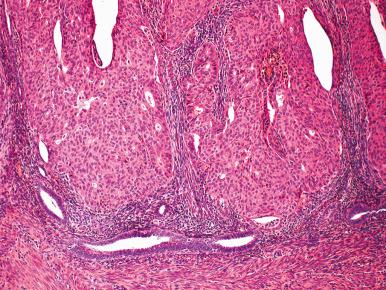
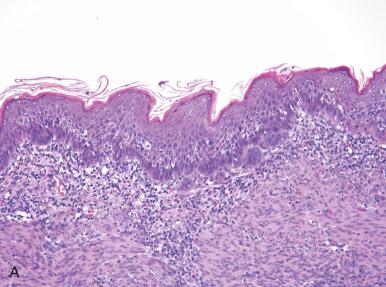
A similar pitfall is the misinterpretation of metastatic carcinoma to the cervix as native squamous metaplasia. Finally, atypical polypoid adenomyomas, which combine morular metaplasia with atypical glands in a myomatous stroma, may be confused with conventional morular metaplasia in polyps or adenocarcinoma. Both of these are discussed in greater detail in Chapter 19 .
Like squamous differentiation, mucinous metaplasia ranges from simple cuboidal or columnar mucinous epithelium to complex proliferations associated with adenocarcinoma. A rare variant, termed intestinal metaplasia, is detailed later. Mucinous metaplasia may accompany tubal or squamous metaplasia in glands or on the surface, and this combination of changes is typically seen in endometria from patients on hormonal replacement therapy.
The extent of mucinous metaplasia determines the level of concern by the pathologist. Nucci et al. have described three types (A to C). The first, type A, consists of cuboidal, endocervical-type epithelium involving the endometrial surface or present within polyps or glands ( Fig. 18.13A ). This pattern usually occurs in samples from perimenopausal women and presumably signifies epithelial transitions related to hormonal effects. Type B metaplasias exhibit mild architectural complexity and slight (pseudo) papillary architecture (see Fig. 18.13B ), which lack true stromal papillae (discussed later). In our experience, when papillary architecture is subtle or focal, there is a low risk of coexistent endometrial neoplasia. Nevertheless, periodic sampling should be considered if there is epithelial complexity with mucinous differentiation (see Fig. 18.13C ; Table 18.3 ). The third, type C, consists of cribriform arrangements of mucinous epithelium within glands ( Fig. 18.14 ) or free-floating mucinous epithelium exhibiting a microglandular or villous architecture ( Fig. 18.15A and B ). These carry a significant risk of adenocarcinoma (75%) on subsequent samplings or hysterectomy, although most do not demonstrate myoinvasion ( Table 18.4 ). Another worrisome pattern consists of conspicuous papillary architecture or endometrial glands with papillary mucinous, ciliated, or combined mucociliated epithelium ( Fig. 18.16A, B ; see Fig. 18.15C–F ). These patterns are equivalent to a diagnosis of EIN. A small series of papillary lesions was found not to be associated with cancer and may signify a subset with limited neoplastic potential. Nevertheless, similar changes within glands or polyps may be associated with neoplasia and should be managed with the intent to exclude EIN and followed closely to exclude papillary adenocarcinomas with mucinous differentiation. Hysterectomies performed for papillary and microglandular patterns may not yield frankly invasive adenocarcinomas; however, they merit classification as neoplasia and warrant close follow-up if hysterectomy is not desired.
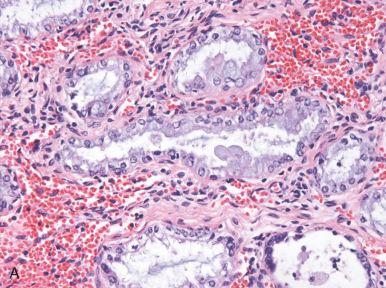
| Pattern(s) | Management |
|---|---|
| Surface | |
|
Routine clinical |
|
Routine clinical |
|
Repeat sample in 3–6 mo |
| Squamous | |
| Isolated morule | Repeat sample in 6 mo |
| Morule and proliferation | Repeat sample in 6 mo |
| Morule and EIN | EIN protocol a |
| Morule and cancer | Cancer protocol |
| Ciliated | |
| Simple tubal metaplasia | Routine clinical |
| Complex tubal metaplasia | EIN protocol a |
| EIN with tubal metaplasia | EIN protocol a |
| Mucinous | |
| Simple mucinous metaplasia | Routine clinical |
| Papillary mucinous proliferation | EIN protocol a |
| Microglandular mucinous proliferation | EIN protocol a |
| Eosinophilic | |
| Eosinophilic metaplasia | Routine clinical |
| Eosinophilic EIN | EIN protocol a |
a See Chapter 17 .
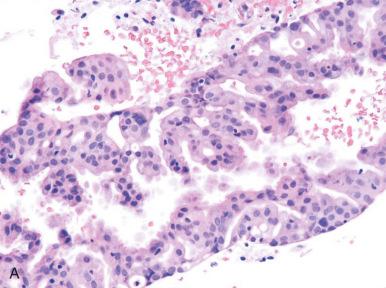
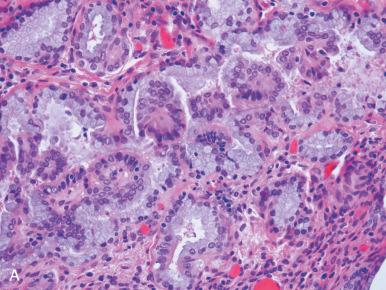
| Classification | Description | Cancer on Follow-Up (%) |
|---|---|---|
| Type A | Simple or focal, papillary | 0 |
| Type B | Complex microglands | 64 b |
| Type C | Type B + atypia | 100 |
b Most were noninvasive or invasive through less than one-third of the myometrial thickness.
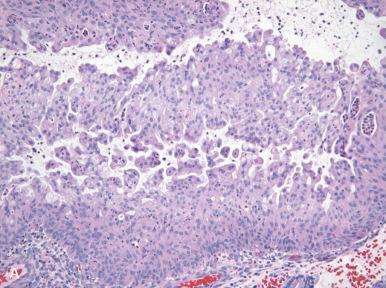
Vang and Tavassoli have examined the criteria of Nucci et al and compared them with published criteria for endometrioid proliferations. The sensitivity and specificity of classic endometrioid criteria, diagnostic of neoplasia, for myoinvasion were 20% and 71.4%, respectively. In contrast, types A, B, and C of mucinous differentiation carried a 0%, 70%, and 30% sensitivity and 81%, 52%, and 67% specificity, respectively, for myoinvasion. Combined categories B (papillary) and C (microglandular) were 100% sensitive for myoinvasion, with 19% specificity. This is not unlike the findings of Nucci et al., who noted that most cancers associated with type C lesions were not myoinvasive.
The natural history of mucinous metaplasias is not well defined. In general, metaplasias that are not accompanied by architectural complexity are not considered a risk. In our practice, mucinous lesions with any epithelial complexity are recommended for a follow-up sample in 6 months (see Tables 18.3 and 18.4 ). Microglandular or papillary lesions require, at the least, a dilation and curettage and, if persistent, hysterectomy. These lesions, even with a bland cytology, may be aggressive. Approximately 75% of lesions with microacinar architecture will be followed by a diagnosis of endometrial adenocarcinomas, which may demonstrate mucinous or endometrioid differentiation. An important issue to keep in mind is that premalignant lesions (EIN) treated with high-dose progestins may induce mucinous differentiation in the lesional glandular epithelium, and these foci may not show the degree of intraglandular complexity seen in untreated EIN with mucinous differentiation (see Fig. 18.16B ).
The primary distinction that the pathologist must make when confronted with mucinous differentiation in an endometrial curetting is between microglandular changes of cervical origin and abnormal mucinous epithelium of uterine origin. Qiu and Mittal have compared these two entities and found the following features to favor an endometrial origin ( Fig. 18.17 ; Table 18.5 ) :
Absence of prominent subnuclear vacuoles
Luminal squamous metaplasia
Stromal foam cells
High mitotic index (more than 3 per 10 high-power field)
Presence of vimentin staining
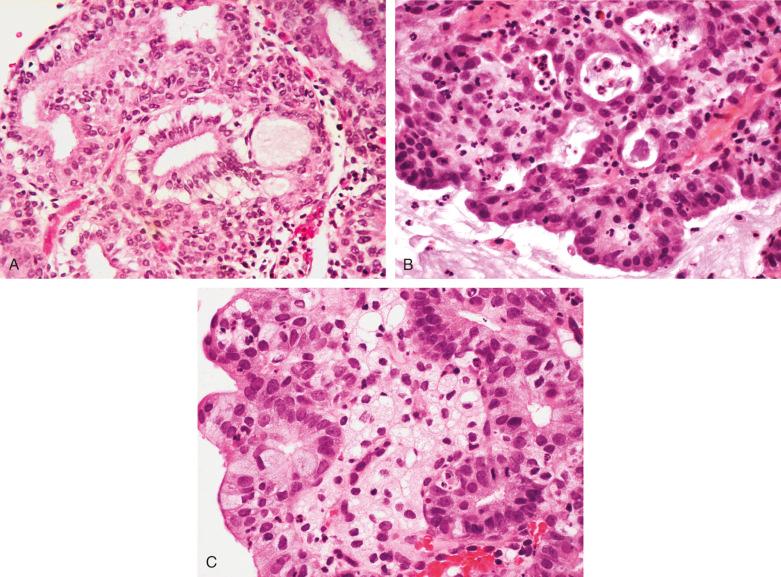
| Parameter | MGC | Endometrial Carcinoma |
|---|---|---|
| Foamy stromal cells | Absent | Present |
| MIB-1 staining | Low | High |
| Subnuclear vacuoles | Present | Absent |
| Subcolumnar squamous metaplasia | Present | Rare |
| Luminal squamous metaplasia | Absent | Present |
| Vimentin | Negative | Positive |
The presence of reserve-like subsurface epithelial populations in the areas flanking the microglandular pattern also suggests a cervical origin. The pathologist should be prepared for difficult cases, including the juxtaposition of tumor and endocervical mimics ( Fig. 18.18 ).
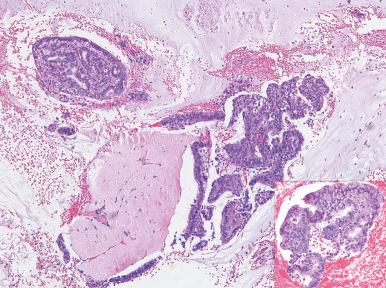
A rare variant of mucinous metaplasia is intestinal metaplasia of the endometrium ( Fig. 18.19A ). McCluggage et al. have shown that 17% of mucin-positive endometrioid adenocarcinomas contain mucin intracytoplasmic O-acetylated sialomucins, which they determined as signifying intestinal differentiation. In this setting, the morphologic features of intestinal differentiation were not appreciated. However, others have shown conspicuous intestinal or gastric differentiation in uterine polyps or on the endometrial surface (see Fig. 18.19B ). The implication of these studies is that müllerian epithelium is capable of undergoing intestinal differentiation. In the absence of neoplasia, the prospective risk of intestinal metaplasia is unknown.
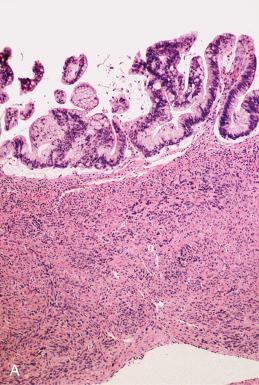
Cilia are common in the cervix, lower uterine segment, and endometrial lining epithelium during the endometrial cycle, being most conspicuous in the follicular phase, and do not merit mention on the pathology report. Extensive tubal metaplasia is usually encountered at menopause, associated with anovulatory states (persistent follicle), endometrial polyps, and in endometria that are responding to hormonal replacement therapy or undergoing evolution to a postmenopausal (inactive or atrophic) pattern. These associations suggest a relationship to excess estrogen.
The histologic features of tubal metaplasia include conspicuous cilia, clear round cells similar to those seen in the fallopian tube, and eosinophilic luminal borders ( Fig. 18.20A ). Like the other forms of metaplasia, tubal metaplasia may be seen in glands (see Fig. 18.20A–D ) or as detached or superficial-appearing fragments of epithelium ( Fig. 18.21 ). It may be simple (see Figs. 18.20A and 18.21A ), associated with mild epithelial complexity (see Fig. 18.20B ), or associated with frank neoplasia (see Figs. 18.20C and D and 18.21B and C ). The latter includes three entities. EIN with tubal differentiation exhibits the characteristic gland crowding and altered epithelial architecture, with focal epithelial tufting and stratification (see Fig. 18.20C and D ). Rarely, microglandular patterns akin to those seen in mucinous metaplasia may be encountered and carry the same significance (see Fig. 18.21B and C ). Finally, frank adenocarcinomas can exhibit prominent tubal differentiation ( Fig. 18.22 ). Like the other forms of altered differentiation, management should be tailored to the degree of complexity of both the metaplasia and coexisting glands (see Table 18.3 ).
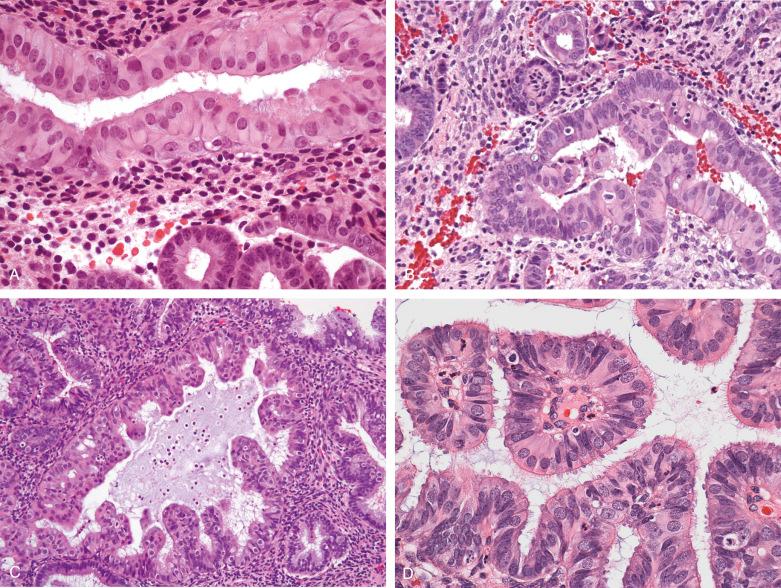
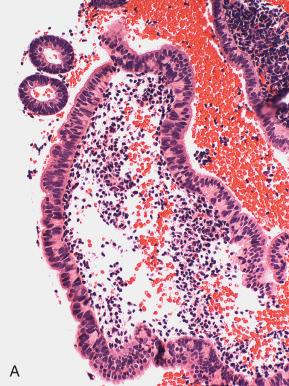
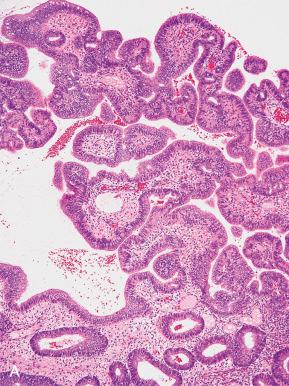
Become a Clinical Tree membership for Full access and enjoy Unlimited articles
If you are a member. Log in here